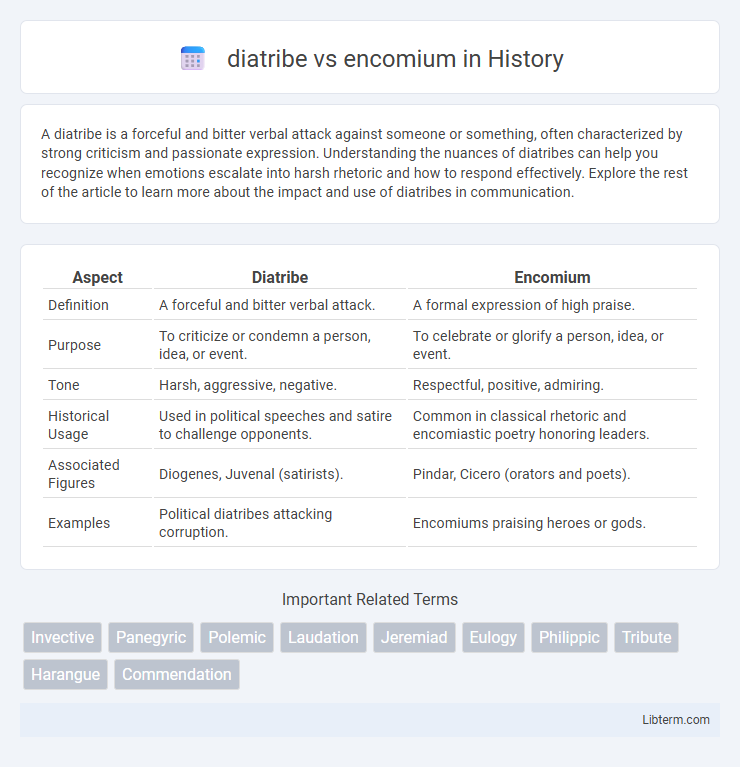A diatribe is a forceful and bitter verbal attack against someone or something, often characterized by strong criticism and passionate expression. Understanding the nuances of diatribes can help you recognize when emotions escalate into harsh rhetoric and how to respond effectively. Explore the rest of the article to learn more about the impact and use of diatribes in communication.
Table of Comparison
| Aspect | Diatribe | Encomium |
|---|---|---|
| Definition | A forceful and bitter verbal attack. | A formal expression of high praise. |
| Purpose | To criticize or condemn a person, idea, or event. | To celebrate or glorify a person, idea, or event. |
| Tone | Harsh, aggressive, negative. | Respectful, positive, admiring. |
| Historical Usage | Used in political speeches and satire to challenge opponents. | Common in classical rhetoric and encomiastic poetry honoring leaders. |
| Associated Figures | Diogenes, Juvenal (satirists). | Pindar, Cicero (orators and poets). |
| Examples | Political diatribes attacking corruption. | Encomiums praising heroes or gods. |
Understanding Diatribe: Definition and Origins
Diatribe is a forceful and bitter verbal attack or criticism aimed at a particular person, idea, or institution, originating from the Greek word "diatribe," meaning "a prolonged discussion." Historically, it emerged in classical rhetoric as a method for philosophers like Cynics and Stoics to challenge prevailing opinions through pointed, often hostile language. Understanding diatribe involves recognizing its function as a rhetorical device designed to provoke thought and highlight perceived flaws, contrasting with encomium's praise-based approach.
Exploring Encomium: Meaning and Historical Context
Encomium is a formal expression of high praise, originating from ancient Greek rhetoric where it served as a cornerstone in oratory practices to honor individuals or virtues. Historically, encomia were delivered during public ceremonies, often celebrating heroes, gods, or notable achievements, solidifying their role in cultural and political life. This rhetorical form contrasts sharply with diatribe, which is characterized by critical, often aggressive discourse aimed at denunciation rather than admiration.
Key Differences Between Diatribe and Encomium
Diatribe is a forceful and bitter verbal attack aimed at criticizing a person or idea, characterized by negative tone and condemning language. Encomium, in contrast, is a formal expression of praise and admiration, often highlighting virtues and achievements with a positive and celebratory tone. The key difference lies in diatribe's purpose to denounce and disparage, while encomium seeks to honor and commend.
Purposes and Functions in Rhetoric
A diatribe serves the rhetorical purpose of vehemently criticizing or condemning a person, idea, or practice, often using emotional and persuasive language to provoke strong reactions and highlight perceived faults. In contrast, an encomium functions as a formal expression of high praise or commendation, aiming to elevate the subject by emphasizing virtues, achievements, or admirable qualities through eloquent and celebratory discourse. Both serve distinct roles in rhetoric by shaping audience perception: diatribes foster opposition and urgency for change, while encomiums reinforce respect and admiration.
Language and Tone: Comparing Diatribe and Encomium
Diatribe employs harsh, critical language with a confrontational and accusatory tone designed to provoke or condemn, often using sarcasm and irony to emphasize faults. Encomium features elevated, praising language with a celebratory and respectful tone aimed at extolling virtues and achievements, utilizing ornate and laudatory expressions. Both rely heavily on rhetoric but differ fundamentally in emotional appeal and intent, shaping their distinct linguistic and tonal characteristics.
Famous Examples of Diatribes in Literature
Diatribes, characterized by vehement denunciations, appear prominently in works such as Jonathan Swift's "A Modest Proposal," where scathing social criticism unfolds through ironic outrage. Another notable example is Martin Luther King Jr.'s "Letter from Birmingham Jail," which combines passionate rebuke with logical argumentation against racial injustice. These powerful diatribes contrast encomiums, which are formal expressions of high praise, by emphasizing aggressive critique rather than admiration.
Notable Encomia Throughout History
Notable encomia throughout history include Cicero's praise of Julius Caesar, which highlighted his leadership and military prowess, and Pericles' Funeral Oration, celebrated for honoring Athenian democracy and valor. Encomia often served to elevate figures by emphasizing their virtues and achievements, contrasting sharply with diatribes that criticize and denounce. These laudatory speeches functioned as pivotal tools in shaping public perception and preserving historical legacies.
Effects on Audience Perception
A diatribe powerfully influences audience perception by evoking strong emotional responses such as anger or outrage, often polarizing opinions through harsh criticism or denunciation. In contrast, an encomium enhances audience perception by fostering admiration and positive regard towards the subject, emphasizing qualities and achievements that inspire respect and approval. Both rhetorical strategies shape audience attitudes but through opposing emotional appeals--one through condemnation and the other through praise.
Common Misconceptions and Confusions
Diatribe and encomium are often confused due to their rhetorical nature, but they serve opposite purposes: diatribe is a forceful, bitter verbal attack criticizing a subject, whereas encomium is a formal expression of high praise. Common misconceptions arise when diatribes are mistakenly viewed as mere complaints, overlooking their structured critique intended to provoke reflection. Similarly, encomiums can be wrongly perceived as superficial flattery, ignoring their role in highlighting virtues with eloquence and sincerity.
Choosing Between Diatribe and Encomium in Writing
Choosing between diatribe and encomium in writing depends on the intended tone and purpose: diatribe delivers a forceful, critical attack on a subject, utilizing strong, negative language to persuade through condemnation. Encomium, conversely, employs praise and positive rhetoric to celebrate and elevate its subject, often used to inspire admiration or respect. Effective writing harnesses the emotional impact of diatribe for critique or the uplifting power of encomium for affirmation, aligning style with the desired audience response.
diatribe Infographic

 libterm.com
libterm.com